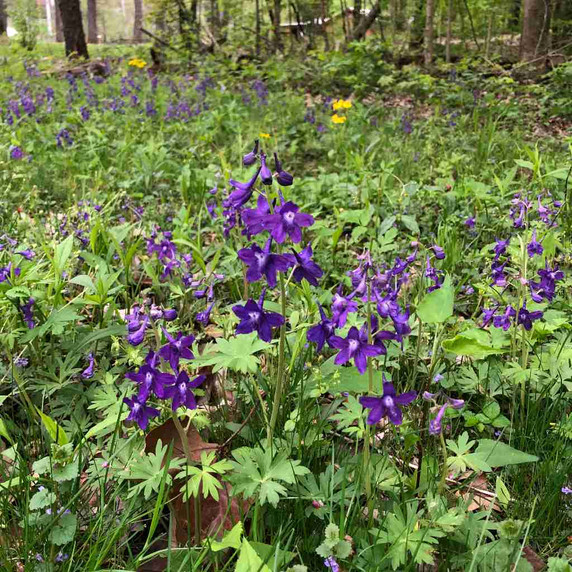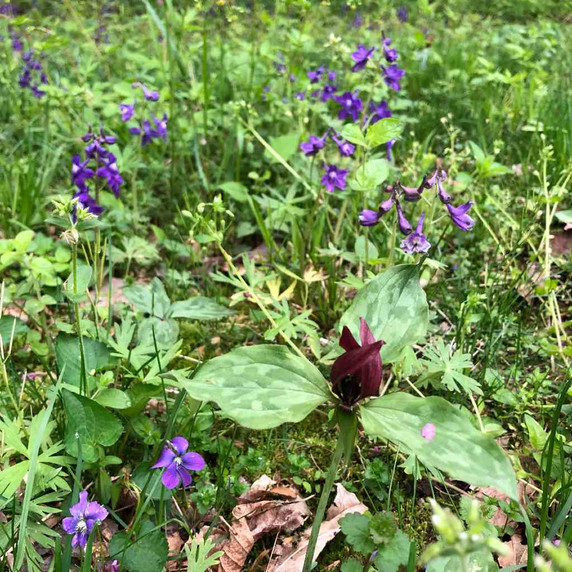
COMING SOON - Delphinium tricorne - DWARF LARKSPUR (dies back during May-early June)
Showy spring ephemeral (shows up quickly and dies back after bloom in early summer). Purple-blue to blue flowers.
Fairly adaptable to garden conditions.
Blooming time: April/May
Size: usually 1'” tall x 0.75' wide (in optimum conditions up to 2' tall x 1.5' wide)
USDA zones: 3 to 7
Culture: best in dappled sun, dappled shade, half shade. Tolerates full sun, especially in cooler areas. Average soil with average moisture (medium) amended with some compost, leaf compost and mulch with organic debris (leaves, shredded leaves or little bit of bark mulch). Loamy, organic rich soils, but is fairly adaptable (slightly acidic, alkaline, average). Avoid waterlogged soils.
Tolerant to heat and humidity, but it's not recommended for deep South gardens (more than zone 7).
Moisture Needs: average - medium to medium-moist
Origin: Native wildflower to Midwest and south eastern USA, often found on slopes - in deciduous woodlands, woodland edges and bluffs, rocky cliffs along rivers on mesic to slightly dry conditions. See the BONAP distribution map.
Deer/rabbit resistant: yes / yes
Attracts Butterflies or Pollinators: yes/ yes
Attracts Hummingbirds: yes
Pot Size: square 3.5" x 4" perennial pot
Plant combinations: Great spring plant for half shade gardens, woodland gardens, transition spots (with some direct sunlight, but also some shade). Also good for partially shaded parts of rock gardens. Looks the best if combined with grassy-leaves of Carex (sedges) or Deschampsia.
Good companions are other spring ephmerals like Claytonia, Jeffersonia, Mertensia, Sanquinaria,Trillium and also spring bulbs! Or plants like Dicentra, Epimedium, Geranium maculatum, Helleborus, Heuchera, Hosta, Lathryrus vernus, Polygonatum, Phlox divaricata, Primula, Tradescantia, Viola.
Pictures copyright : US Perennials

COMING SOON - Delphinium tricorne - DWARF LARKSPUR (dies back during May-early June)
Showy spring ephemeral (shows up quickly and dies back after bloom in early summer). Purple-blue to blue flowers.
Fairly adaptable to garden conditions.
Blooming time: April/May
Size: usually 1'” tall x 0.75' wide (in optimum conditions up to 2' tall x 1.5' wide)
USDA zones: 3 to 7
Culture: best in dappled sun, dappled shade, half shade. Tolerates full sun, especially in cooler areas. Average soil with average moisture (medium) amended with some compost, leaf compost and mulch with organic debris (leaves, shredded leaves or little bit of bark mulch). Loamy, organic rich soils, but is fairly adaptable (slightly acidic, alkaline, average). Avoid waterlogged soils.
Tolerant to heat and humidity, but it's not recommended for deep South gardens (more than zone 7).
Moisture Needs: average - medium to medium-moist
Origin: Native wildflower to Midwest and south eastern USA, often found on slopes - in deciduous woodlands, woodland edges and bluffs, rocky cliffs along rivers on mesic to slightly dry conditions. See the BONAP distribution map.
Deer/rabbit resistant: yes / yes
Attracts Butterflies or Pollinators: yes/ yes
Attracts Hummingbirds: yes
Pot Size: square 3.5" x 4" perennial pot
Plant combinations: Great spring plant for half shade gardens, woodland gardens, transition spots (with some direct sunlight, but also some shade). Also good for partially shaded parts of rock gardens. Looks the best if combined with grassy-leaves of Carex (sedges) or Deschampsia.
Good companions are other spring ephmerals like Claytonia, Jeffersonia, Mertensia, Sanquinaria,Trillium and also spring bulbs! Or plants like Dicentra, Epimedium, Geranium maculatum, Helleborus, Heuchera, Hosta, Lathryrus vernus, Polygonatum, Phlox divaricata, Primula, Tradescantia, Viola.
Pictures copyright : US Perennials











